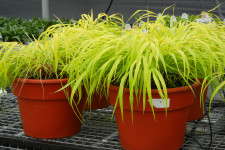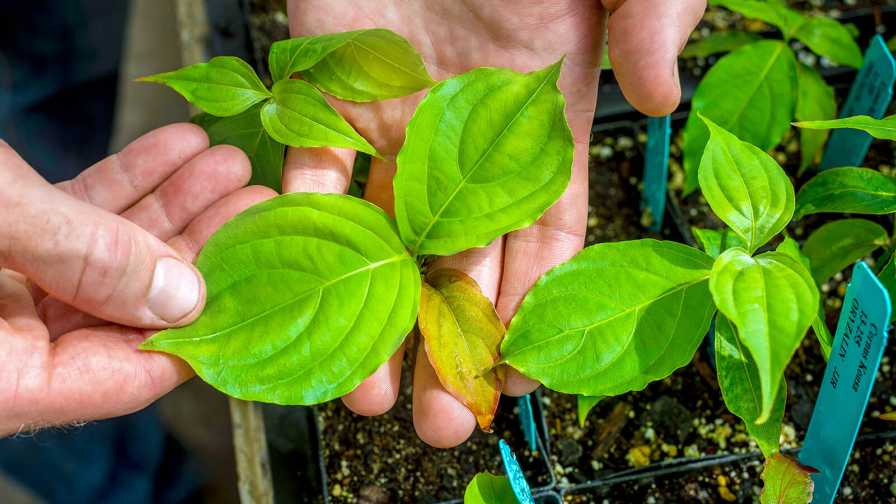Ornamental Grasses: Not All Grasses Are Created Equal

With the popularity of ornamental grasses, many growers are offering them in their perennial product lines. Some growers handle and produce ornamental grasses as if they were all the same, but the truth is, growing several varieties in a similar manner will often lead to production and quality issues.
Grasses can generally be categorized into three groups: cool-season grasses, warm-season grasses and sedges. These categories correlate with the seasonality or the time of year when they are actively growing. These groupings are also influenced by the origin of the individual grasses. When growers receive starting materials, how they grow the crops and their success is greatly influenced by the type of grasses they are producing.
About Cool-Season Grasses
Cool-season grasses are at their prime and flourish when they are grown with cool temperatures (60 to 75°F). These grasses typically begin to grow during the late winter or early spring and flower from late spring to early summer. The growth slows down during the heat of the summer, and many cool-season grasses go dormant during this time. Several cool-season grasses resume growth with the cool fall temperatures. Many are evergreen, while others may be evergreen in the South yet go completely dormant when they are grown in northern climates.
Cool-season grasses include Calamagrostis acutiflora, festuca, helictotrichon and koeleria.
Keys To Producing Cool-Season Grasses
Starting materials for cool season grasses should be received in the late summer or early fall, when plants are needed for early spring sales the following year or when they are being grown in large container sizes. Planting them at this time allows for the best bulking, as the plants put on most of their growth during these cooler months.
Spring planting is usually reserved for production in smaller container sizes, as most cool-season grasses produce flower plumes fairly early in the growing season. Spring planting may not allow enough time for bulking.
About Warm-Season Grasses
Warm-season grasses perform the best when they are grown with warm temperatures (75 to 90°F). These grasses emerge later in the spring than cool-season grasses. Growth usually begins in the mid-spring as temperatures rise. Warm-season grasses typically flower in the late summer or fall, and they usually become dormant prior to the onset of winter.
Some warm-season grasses include: acorus, andropogon, arundo, Calamagrostis brachytricha, chasmanthium, cortadaria, erianthus, hakonechloa, miscanthus, panicum, pennisetum, schizachyrium, spodiopogon and sporobolus.
Keys To Producing Warm-Season Grasses
Because warm-season grasses grow most actively during warmer months, it is best to receive starting materials from the late spring to mid-summer. Avoid bringing in starting materials of these grasses in the fall.
Keep in mind that warm-season
grasses prefer warm temperatures for growth and bulking; therefore, if cool temperatures (less than 60°F) are present, they may need to be grown in a heated facility until they are properly bulked up. Unless significant heat can be provided, avoid planting liners in the late winter or early spring.
Sedges (Carex)
Carex belong to the family Cyperaceae, which includes nearly 4,000 species worldwide. Although sedges look similar to ornamental grasses, they are not true grasses at all. Sedges are usually evergreen, while most ornamental grasses go through a complete dormancy.
There are numerous variations of carex in commercial production. Some types are clumping, and others have creeping or spreading plant habits. Additionally, there are many foliar colorations and variegated forms available. Unlike most ornamental grasses, which prefer to be grown in full sun, most sedges grow best in partial shade. Some cultivars can be grown in partial to full shade.
Keys To Producing Sedges
Starting materials can be received and planted from early spring through late summer. Avoid planting them in the fall. Because many sedges are evergreen and tend to flower in late spring to early summer, it is often best to plant them during mid to late summer the year before they are to be sold to allow adequate time for bulking.
Sedges tend to grow more like warm-season grasses. They can, how-ever, be grown with slightly cooler temperatures. Additionally, sedges grow slower and are more sensitive to cultural conditions, such as soil moisture and fertility levels, than most ornamental grasses.
Most carex cultivars (i.e., ‘Banana Boat,’ ‘Bowles Golden’ and ‘Ice Dance’) prefer to be kept moist during production (above average water requirements). But several cultivars, such as ‘Evergold,’ have average to below average moisture requirements.
Production Tips For All Grasses
While transplanting, avoid planting the liners or bareroot too deeply or too shallow. Always plant to match the original soil line of the liner with the growing mix of the final container. Ensure there are no air pockets and the roots have good contact with the growing mix.
In the landscape, the majority of ornamental grasses perform best when they are grown in full sun. However, in containerized production, many grasses grow best when some shade is provided (35 percent). Although shading is optional for most grasses, several types (i.e., carex, chasmanthium and hakonechloa) benefit when they are grown with lower light intensities.
It is important to keep the root zone of newly potted grasses moist, but not wet, until they become established.
All ornamental grasses will require more frequent irrigations once they become root-bound. Most ornamental grasses are moderate feeders and require slightly more fertilization than most perennials. Maintaining pH between 5.5 and 6.3 and feeding with rates of 100 to 150 parts per million (ppm) nitrogen is suitable for grasses with moderate to heavy fertility requirements. Several grasses (i.e., acorus, carex, festuca, hakonechloa and koeleria) are light feeders and should be grown with lower fertility levels (50 to 100 ppm nitrogen).
Takeaways
To increase their successes with ornamental grasses, growers must identify which category of grasses they are growing and plant them at the appropriate times of the year. Proper transplant times combined with planting them properly and practicing good water and fertility management will greatly improve the growth, appearance and quality attributes of ornamental grasses.









